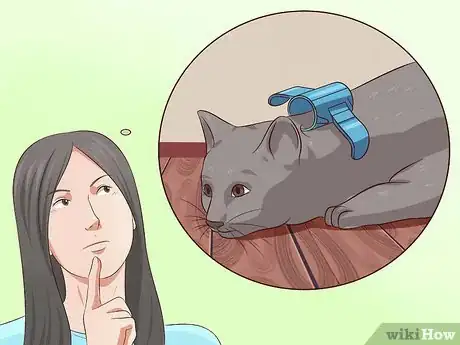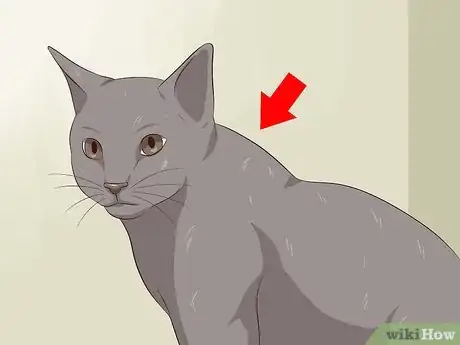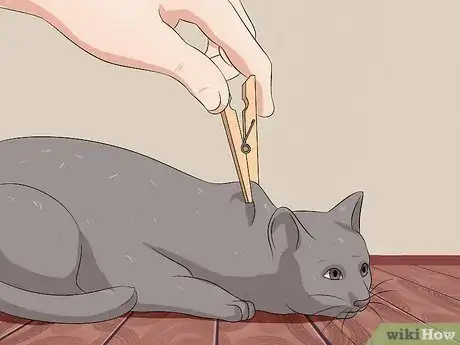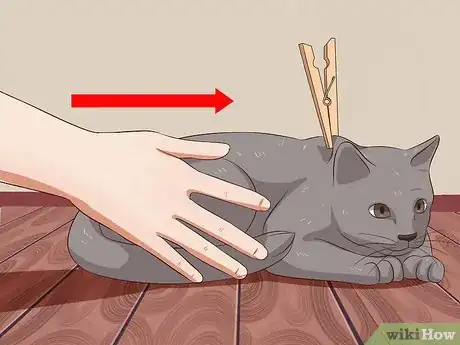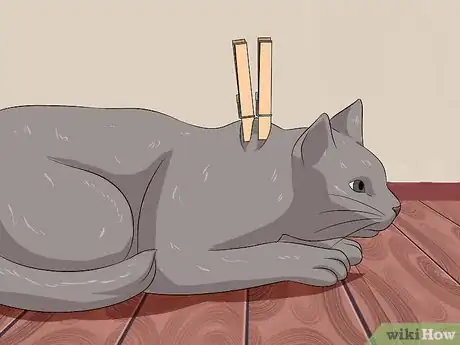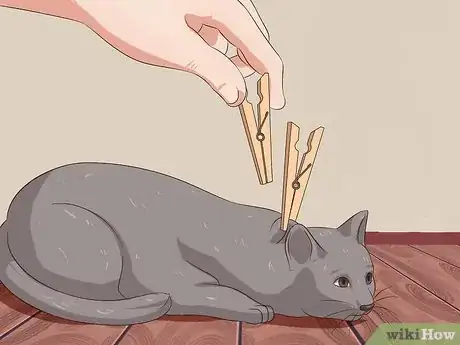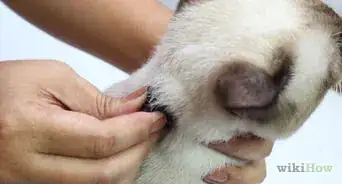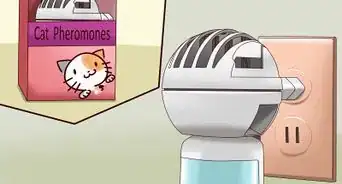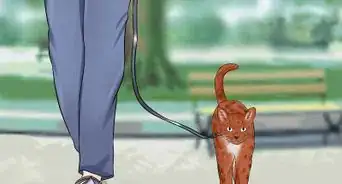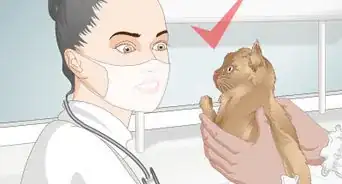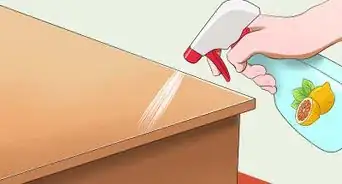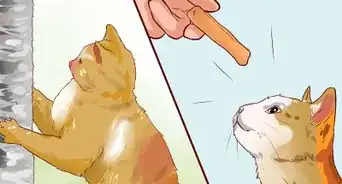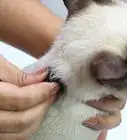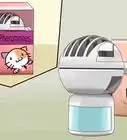This article was co-authored by Pippa Elliott, MRCVS. Dr. Elliott, BVMS, MRCVS is a veterinarian with over 30 years of experience in veterinary surgery and companion animal practice. She graduated from the University of Glasgow in 1987 with a degree in veterinary medicine and surgery. She has worked at the same animal clinic in her hometown for over 20 years.
This article has been viewed 290,653 times.
You can "deactivate" most cats with a binder clip. Sometimes called PIBI, or Pinch-Induced Behavioral Inhibition, this procedure is safe and comfortable for almost all cats.[1] This works best if the cat knows you. Use this procedure only when necessary, not just for fun.
Steps
Testing the Cat
-
1Use this only when necessary. In one study, thirty out of thirty-one cats reacted positively, and none showed signs of pain or fear.[2] Still, your cat may not enjoy it. Many vet technicians consider "scruffing" techniques old-fashioned, and too intense for regular use.[3] Some say this technique is a more gentle option, but this is controversial.[4]
- Try this when you need to trim the cat's claws or give it medicine.
-
2Remove the collar. You'll need full access to the cat's neck. If you leave the collar on, it could choke or pinch the cat.Advertisement
-
3Find the scruff. Cats have a loose fold of skin at the back of the neck, called a scruff. If your cat has an unusually small scruff, that you cannot easily grab, be careful. You don't want to pinch too hard.
-
4Grasp the scruff and watch the cat's reaction. Firmly grasp the scruff and watch your cat's reaction. If the cat relaxes, it will most likely respond well to the next step: deactivating.[5] If the cat struggles or meows, let go and try a different tactic, such as wrapping the cat.
Deactivating the Cat
-
1Place a clip over the cat's scruff. If the cat relaxed when you grabbed the scruff, the clip should have the same effect. In one study, two-inch (5 cm) binder clips had the best results.[8] Place the clip over the scruff, just behind the ears.
- You can try using a kitchen clip or clothespin. Smaller or more forceful clips may cause a painful pinch, but cats' reactions vary.
-
2Gently push the cat onto its side. A relaxed cat may flop over on its own. If it doesn't, a gentle push on the back legs should convince it. A fully relaxed cat may bring its paws up near its face, and/or curl up with its tail straight down or between its legs.
- If the cat is standing, the tail between the legs is a sign of fear, not comfort.
-
3Add additional clips if necessary. Some cats may not relax fully, but do not show any signs of fear or discomfort. If this happens, put one or two more clips on the scruff, in a line along the spine. Stop and remove the clips if the cat struggles, meows, or breathes heavily.
- Some cats respond to clips placed anywhere along the skin above the spine, down the entire back. This typically has less effect than the neck.[9]
-
4Remove the clips after a few minutes. There are no expert recommendations for how long the clips can be left on. Most clips shouldn't cause any damage to your cat's skin, but your cat may become annoyed after a while. Aim for a short, positive experience to make future procedures easier.
Expert Q&A
Did you know you can get expert answers for this article?
Unlock expert answers by supporting wikiHow
-
QuestionIs this a good way to calm a mad cat?
 Pippa Elliott, MRCVSDr. Elliott, BVMS, MRCVS is a veterinarian with over 30 years of experience in veterinary surgery and companion animal practice. She graduated from the University of Glasgow in 1987 with a degree in veterinary medicine and surgery. She has worked at the same animal clinic in her hometown for over 20 years.
Pippa Elliott, MRCVSDr. Elliott, BVMS, MRCVS is a veterinarian with over 30 years of experience in veterinary surgery and companion animal practice. She graduated from the University of Glasgow in 1987 with a degree in veterinary medicine and surgery. She has worked at the same animal clinic in her hometown for over 20 years.
Veterinarian
Warnings
- If the cat becomes aggressive, stop the exercise immediately.⧼thumbs_response⧽
- Never lift a cat by the scruff alone. If you need to move the cat, support its back legs with your other hand.⧼thumbs_response⧽
- Don't try this exercise frequently on your cat. Use only if necessary as it may make your cat feel upset or aggressive.⧼thumbs_response⧽
Things You'll Need
- 2-inch (5 cm) binder clip (or clothespin)
References
- ↑ http://www.researchgate.net/publication/5628526_Pinch-induced_behavioral_inhibition_%28%27clipnosis%27%29_in_domestic_cats
- ↑ http://www.researchgate.net/publication/5628526_Pinch-induced_behavioral_inhibition_%28%27clipnosis%27%29_in_domestic_cats
- ↑ http://www.cathealth.com/how-to/how-to-scruff-your-cat
- ↑ http://io9.com/the-one-myth-about-cats-thats-actually-true-1469745000
- ↑ http://www.researchgate.net/publication/5628526_Pinch-induced_behavioral_inhibition_%28%27clipnosis%27%29_in_domestic_cats
- ↑ http://www.researchgate.net/publication/51072259_AAFP_and_ISFM_feline-friendly_handling_guidelines
- ↑ http://www.cathealth.com/how-to/how-to-scruff-your-cat
- ↑ https://www.dvm360.com/view/clipnosis-answer-calming-cats-clinic
- ↑ http://www.researchgate.net/publication/5628526_Pinch-induced_behavioral_inhibition_%28%27clipnosis%27%29_in_domestic_cats
About This Article
Before you deactivate your cat, keep in mind that you should only attempt to do this when it's necessary, like if you're trimming your cat's claws or giving it medicine. To get started, remove your cat's collar if it's wearing one and grab the scruff, or loose skin, at the back of your cat's neck. If your cat struggles or meows, let it go and try a different technique. If your cat relaxes when you grab its scruff, take a clip, like a binder or kitchen clip, and clip it where your fingers are holding the scruff. To learn how to proceed if your cat doesn't respond to the clips, scroll down!
